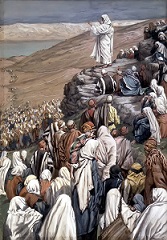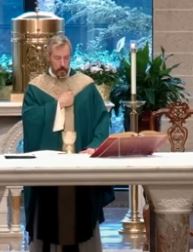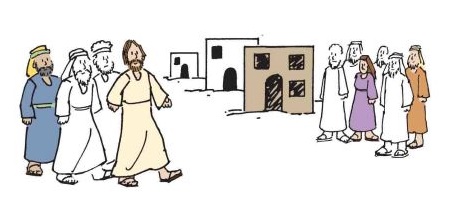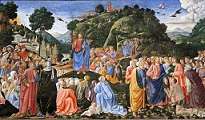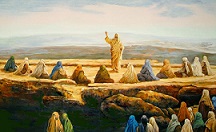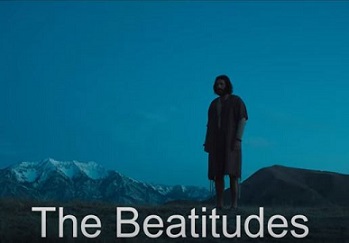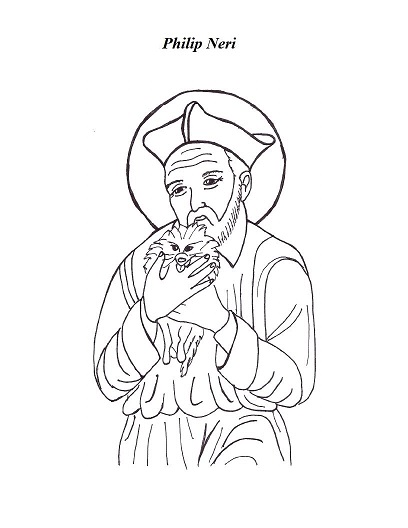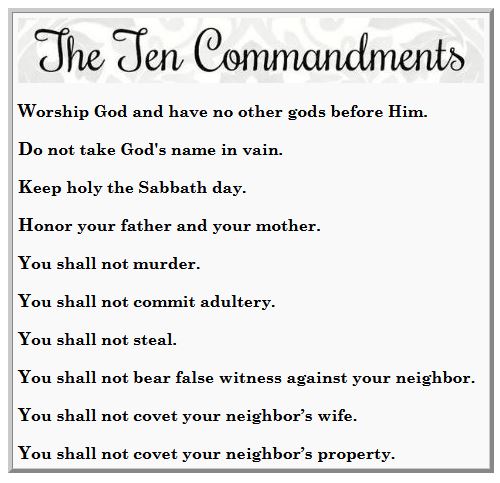Let’s begin with the Sign of the Cross:
We are still in Ordinary Time, and, wherever you were for Mass on Sunday, the priest was wearing a green chasuble. GOSPEL: At Mass this weekend, the Gospel reading was from the Gospel of Luke. We'll solve some puzzles and read the story from the children's bulletin.
ASK: What do you think Jesus was trying to tell his followers? ART: The
Gospel reading we just read is known as “The Sermon
on the Plain.” Last week, we read about Jesus
recruiting Peter, James, and John to be his Apostles
— people who would help Jesus get his message out to
people. By the time of this part of the Gospel, Jesus had
recruited all 12 of his Apostles. Jesus would preach to
his Apostles in open areas, and other people would gather
to listen to Him. In the Sermon on the Plain, Jesus told
people how hard it could be if they decided to follow
him. Here is art from three different artists, all
telling the story about Jesus and the Sermon on the
Plain. Which painting do you like most? Why? The 1st painting was made about 540 years ago. It is on a wall at the Sistine Chapel. It is a fresco. Remember "fresco" means that the artist painted on wet plaster, and the painting is now part of the wall. The painting is big -- about 12 feet high and about 18 feet wide. The painting is really three paintings in one. In the middle, Jesus is standing on a low hill and preaching to people gathered around him. In the lower right corner, Jesus is shown with a semi-nude man kneeling in front of him. The man has leprosy, and the painting depicts the time when Jesus healed a man who had leprosy. And to the right of center, Jesus is shown again with his Apostles. They are together, with Jesus in the lead, and walking down a slight incline. The artist has put halos on Jesus and the Apostles; it is the halos that allows you to know that Jesus is shown in the painting three times. The 2nd painting was made about 130 years ago. The artist began by making a drawing with graphite, the same kind of black stuff that is inside your pencil that you write with. Then, the artist used watercolor paint on top of the graphite drawing. The painting is about two-feet high. The artist wanted to show that Jesus had many followers. The crowd stretched from the far-off shore of a lake all the way up to the top of the big rock where Jesus stood preaching. The artist was French, and he named this "La sermon des béatitudes," which means "the sermon of the beatitudes." The 3rd painting was made in modern times. The artist is still alive. It shows the 12 Apostles sitting in a semi-circle in front of Jesus. They are sitting on a large, flat area in the midst of rocks. Beyond them there are people listening to Jesus preach. SNACK: Remember our
prayer before meals? Join in if you can. Video: The Beatitudes [Three-minute video from "The
Chosen."] TEXTBOOK: This week we’ll do Lesson # 12. It begins on page 111. The lesson is called, "How do we respond to God’s love?" So, let's turn to page 111. [Read all. Do activity on page 113 and “Show what you know” on page 117.] SAINT FEATURED IN CHAPTER: Your textbook has a little paragraph about Saint Philip Neri at the bottom of page 117. Philip Neri was born about 500 years ago in Italy. As a young man, he moved to Rome, a huge city in Italy. Philip studied at a monastery, where men study to become priests. He was a good student, but he decided not to be ordained as a priest then. Back then, the Church was losing many believers. Philip went out onto the streets of Rome and helped poor people. He would begin conversations with strangers by asking them, “Do you want to do good?” Some people would ignore him. Other people would listen to his humor and conversation and do some good thing that Philip encouraged them to do. He taught people about the beauty and truth of the Catholic religion. Many people returned to the church. He would do funny things to get people to listen to God's word. Philip loved to laugh. He loved to tell jokes. He knew that God's plan for us is to be happy and to live in peace with others. Philip loved to share the Gospel and help people to find or rediscover their faith in God. When he was 34 years old, Philip finally was ordained as a priest. Philip's joyous nature helped to bring many people back to the Church. There is a coloring page for St. Philip Neri included in the stack of saints pages that you got for Christmas.
Valentine fill-in-the-blanks for John 3:16. CLOSING PRAYERS: Time to say good bye. :-) [Distribute Our Father and Hail Mary sheets.] We'll begin with the Our Father. You know the words. Read them as we all say them; reading will help you to remember. And then we'll say the Hail Mary; read it, and you will soon know it by heart:
|
